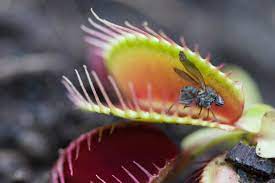
Being a typical kid, I eventually got bored and forgot about the plant. I'm ashamed to admit it, but my Venus flytrap died from lack of attention and care.
That memory file resurfaced after reading that this rare carnivorous plant, only found growing wild in a few remote areas of North and South Carolina, is in peril of disappearing altogether. The most heartbreaking news - the Venus flytrap is not alone.
The conservation organization, NatureServe, analyzed 50 years of data from its network of American and Canadian scientists and found that 40% of animals and 34% of plants in the United States are at risk of extinction, while 41% of ecosystems are facing collapse. Those numbers in such a short amount of time are staggering. They're downright scary!
Their Biodiversity in Nature report identifies unprotected land and where animals and plants face the most threats.
The authors of the report found that habitat degradation, invasive species, dams, and climate change are among the primary threats to biodiversity in the United States. The threats against plants, animals, and ecosystems are greatest in California, Texas, and the southeastern United States.
Among pollinators, bees are particularly threatened, with 37% of assessed species classified "at risk." I was surprised that native bees in the western U.S. are more threatened than bees in the east. Living in the east, I reckon my perceptions are biased after having fewer bugs, birds, and bats visiting our yard.
In spring, I've always enjoyed having curious bumblebees hover a few inches from my nose, checking me out. Last year, there were very few. During the summer, zero bumblebees visited my flowers after the farmers sprayed pesticides over their ever-expanding fields. It wasn't until the autumn wildflowers started blooming that they returned. I was so happy to see my buzzing friends again!
However, it's not only pollinators that are threatened. Various birds, amphibians, fish, and land animals are in danger as well. As far as plants go, cacti top the list, with almost half of the species vulnerable to going extinct. But, unfortunately, that's not all. Two hundred species of trees, 40+ types of grassland, various flowers, ferns, sedges, and other flora also make the list.
What's really frightening is when you realize the same destruction is happening worldwide. How many ecosystems have been lost? What about the animals that depended on the diverse vegetation in those ecosystems? What will it take for people to understand that the future of humanity depends on the health of our natural world?
The Intergovernmental Science-Policy Platform on Biodiversity and Ecosystem Services (IPBES) Assessment Report on Land Degradation and Restoration states that more than 75 % of Earth's land areas are substantially degraded. If this trend continues, more than 90 % of the Earth's land areas could become degraded by 2050, potentially exacerbating climate change and leading to mass migration, conflict, and major food security concerns.
From the rainforests to the deserts, grasslands, swamps, oceans, and beyond, the loss of ecosystems has been caused by changes in land and sea use, exploitation, climate change, pollution, and the introduction of invasive species.
All is not lost, though. I want to be optimistic and say we have not reached the point of no return. We cannot bring back what has been lost, but we can do things to lessen any more loss. Picking up litter, reducing your use of plastics, restoring habitat by planting native flowers, trees, and shrubs, not using pesticides, talking to your friends/neighbors/relatives about this issue and getting them to participate, and just being a good steward of the land, air, and water will make a difference. Each of our small contributions to restoring nature's balance will add up when everyone makes an effort.
Don't wait until tomorrow. Start today.
Sassy Scribblers… on Conservation
 RSS Feed
RSS Feed

